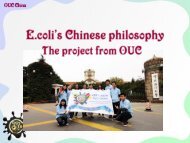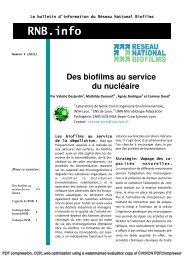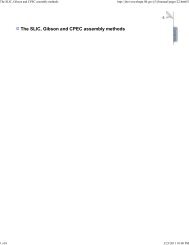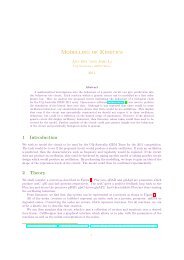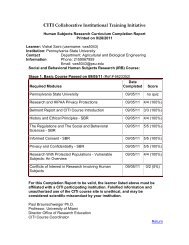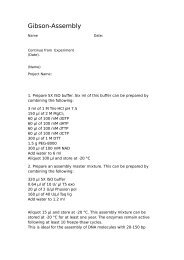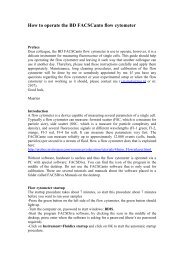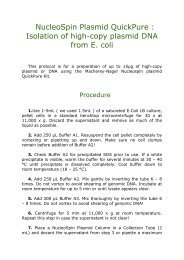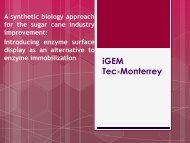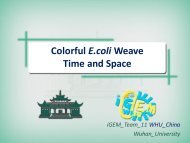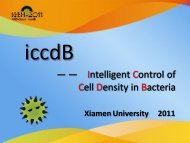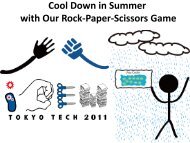Brown-Stanford Championship Presentation - iGEM
Brown-Stanford Championship Presentation - iGEM
Brown-Stanford Championship Presentation - iGEM
You also want an ePaper? Increase the reach of your titles
YUMPU automatically turns print PDFs into web optimized ePapers that Google loves.
Synthe'c Biology Applica'ons for<br />
Space Explora'on<br />
<strong>Brown</strong>-‐<strong>Stanford</strong> <strong>iGEM</strong> 2011<br />
Andre Burnier, Evan Clark, Julius Ho, Ryan Kent, Lei Ma, Eli Moss, Jesse Palmer, Max Song, Jovian Yu<br />
<strong>Brown</strong>-<strong>Stanford</strong> <strong>iGEM</strong>
<strong>Brown</strong>-<strong>Stanford</strong> <strong>iGEM</strong>
Energy ProducIon<br />
Harvest methane from the MarIan surface,<br />
alcohol fermentaIon from<br />
photosyntheIcally produced sugars, and<br />
microbial hydrogen producIon.<br />
Cellular Factories<br />
Produce a wide range of biological<br />
products-‐-‐such as drugs, nutrients,<br />
enzymes, and reagents-‐-‐from a DNA<br />
database and an interchangeable cellular<br />
chassis<br />
<strong>Brown</strong>-<strong>Stanford</strong> <strong>iGEM</strong><br />
In situ resource use for colony assembly<br />
Minimize upmass of construcIon<br />
materials by mineralizing exisIng regolith.
PowerCell<br />
• Goal<br />
Develop a universal, sustainable<br />
energy source to power biological<br />
tools<br />
• ApplicaIon<br />
Feed the biological tools that will<br />
transform raw materials into fuel,<br />
food, drugs, and other products<br />
useful to seTlers<br />
<strong>Brown</strong>-<strong>Stanford</strong> <strong>iGEM</strong>
The Premise<br />
• All organisms need a set of essenIal elements (CHONPS)<br />
• Our goal:<br />
<strong>Brown</strong>-<strong>Stanford</strong> <strong>iGEM</strong>
Anabaena PCC7120<br />
• PhotosyntheIc<br />
• Freshwater<br />
• Sucrose as osmoIc buffer<br />
• Inducible sucrose producIon<br />
with salt stress<br />
• Nitrogen fixing<br />
• Products diffuse into other cells<br />
<strong>Brown</strong>-<strong>Stanford</strong> <strong>iGEM</strong><br />
N2<br />
Nitrogenous<br />
products
Sucrose secre'on<br />
Salt induced<br />
sucrose<br />
producIon<br />
<strong>Brown</strong>-<strong>Stanford</strong> <strong>iGEM</strong><br />
• We focused on sugar secreIon<br />
• CscB sucrose permease<br />
• Why sucrose?<br />
• Un-‐metabolized
Sucrose u'liza'on<br />
• Can other organisms survive on generated sucrose?<br />
• TesIng growth with E. coli W on minimal media + sucrose<br />
<strong>Brown</strong>-<strong>Stanford</strong> <strong>iGEM</strong>
Construct Design<br />
• CscB under control of psaC promoter<br />
• psaC is protein in photosystem I<br />
• isolated upstream region (~400bp)<br />
• expresses CscB only in cells that photosynthesize<br />
• GFP reporter to verify localizaIon<br />
• Full PowerCell construct (BBa_K656012)<br />
<strong>Brown</strong>-<strong>Stanford</strong> <strong>iGEM</strong><br />
psaC cds
DNA Transforma'on<br />
Construct<br />
<strong>Brown</strong>-<strong>Stanford</strong> <strong>iGEM</strong><br />
Failure! Construct<br />
L<br />
• RestricIon enzymes digest foreign DNA taken up by cell<br />
• We need to protect our plasmid…<br />
AvaI<br />
AvaII<br />
AvaIII
Tri-‐Parental Ma'ng<br />
Cargo plasmid pRL25<br />
<strong>Brown</strong>-<strong>Stanford</strong> <strong>iGEM</strong><br />
E. coli DH5aMCR<br />
With helper plasmid<br />
pRL623<br />
Anabaena target cell<br />
E. coli ED8654<br />
with conjugaIon<br />
plasmid pRL443
Results of triparental maIng<br />
<strong>Brown</strong>-<strong>Stanford</strong> <strong>iGEM</strong>
Selec'on Cultures for Anabaena<br />
<strong>Brown</strong>-<strong>Stanford</strong> <strong>iGEM</strong><br />
Day 3 Day 7
Energy ProducIon<br />
Harvest methane from the MarIan surface,<br />
alcohol fermentaIon from<br />
photosyntheIcally produced sugars, and<br />
microbial hydrogen producIon.<br />
Cellular Factories<br />
Produce a wide range of biological<br />
products-‐-‐such as drugs, nutrients,<br />
enzymes, and reagents-‐-‐from a DNA<br />
database and an interchangeable cellular<br />
chassis<br />
<strong>Brown</strong>-<strong>Stanford</strong> <strong>iGEM</strong><br />
In situ resource use for colony assembly<br />
Minimize upmass of construcIon<br />
materials by mineralizing exisIng regolith.
RegoBricks<br />
Goal:<br />
Modularize the well studied process of<br />
biocementaIon.<br />
ApplicaIon:<br />
Reliable, protecIve habitats for any extraterrestrial<br />
seTlement, which are not limited by payload<br />
capabiliIes<br />
<strong>Brown</strong>-<strong>Stanford</strong> <strong>iGEM</strong><br />
Why Sporosarcina pasteurii?<br />
• precipitates calcite by hydrolyzing urea, which is<br />
currently a waste product in space missions<br />
• a spore forming bacterium, allowing populaIons<br />
to survive extreme environmental condiIons
Biocementa'on<br />
• Urease enzyme cleaves urea into ammonia and carbon dioxide<br />
• Ammonia raises the pH causing the formaIon of divalent carbonate anions<br />
• These anions meet with calcium caIons that are in soluIon to form calcium<br />
carbonate crystals<br />
<strong>Brown</strong>-<strong>Stanford</strong> <strong>iGEM</strong>
Protocol -‐ Urease BioBrick<br />
Isolated from pBU11-‐ recombinant E. coli created containing<br />
urease genes from S. pasteurii<br />
PCR amplificaIon RestricIon digest<br />
LigaIon into pSB1C3<br />
<strong>Brown</strong>-<strong>Stanford</strong> <strong>iGEM</strong>
Results & Characteriza'on<br />
• Urease operon successfully transformed into<br />
E. coli, submiTed as part BBa_K656013 in the<br />
registry<br />
• VerificaIon of part funcIonality on urease<br />
test plates; phenol red signal indicates<br />
increases in pH as a result of ureolysis<br />
• Future direcIons<br />
<strong>Brown</strong>-<strong>Stanford</strong> <strong>iGEM</strong>
Going to (near) Space<br />
Goal:<br />
Send balloon into near-‐space;<br />
Stratosphere (24km-‐34km)<br />
mimics condiIons found on<br />
Mars<br />
Temperature<br />
Pressure<br />
UV radiaIon<br />
ApplicaIon:<br />
Gain insight into our<br />
organisms’ potenIal for<br />
space uIlizaIon<br />
<strong>Brown</strong>-<strong>Stanford</strong> <strong>iGEM</strong>
Ballooning video<br />
<strong>Brown</strong>-<strong>Stanford</strong> <strong>iGEM</strong>
Lab Recap<br />
• Generated DNA and submiTed to Registry of Standard Biological Parts:<br />
– Anabaena pSac vegetaIve promoter (BBa_656010)<br />
– CscB sucrose permease from E. coli W (BBa_656011)<br />
– Full Anabaena PowerCell construct (BBa_656012)<br />
– Sporosarcina Urease Operon (BBa_656013)<br />
• Characterized 3 of the newly submiTed parts<br />
• Environmental tolerance tesIng in upper atmosphere<br />
<strong>Brown</strong>-<strong>Stanford</strong> <strong>iGEM</strong>
Human Prac'ces<br />
• What is the moIve to explore<br />
and colonize space?<br />
• What can engineered biology do<br />
for space exploraIon?<br />
• How should we go about<br />
expanding onto other planets?<br />
• What is the value of alien life?<br />
<strong>Brown</strong>-<strong>Stanford</strong> <strong>iGEM</strong>
Outreach<br />
<strong>Brown</strong>-<strong>Stanford</strong> <strong>iGEM</strong>
Outreach<br />
<strong>Brown</strong>-<strong>Stanford</strong> <strong>iGEM</strong>
Outreach<br />
<strong>Brown</strong>-<strong>Stanford</strong> <strong>iGEM</strong><br />
?
Outreach<br />
<strong>Brown</strong>-<strong>Stanford</strong> <strong>iGEM</strong>
Acknowledgements<br />
PowerCell<br />
• Dr. Daniel Ducat, Dr. Jeffrey Way, and Dr. Pamela Silver (Harvard University) for iniIal guidance on<br />
our work with sugar secreIon and inspiring our use of cscB<br />
• Dr. Manuel Varela (Eastern New Mexico University) for cscB gene, Dr. James Golden (UC San Diego)<br />
for cyanobacterial strains, and Dr. Peter Wolk (Michigan State University) for helper plasmid pRL623<br />
• Dr. Jeffrey Elhai (Virginia Commonwealth University) for guidance with transformaIon of Anabaena<br />
RegoBricks<br />
• Dr. Sookie Bang (South Dakota School of Mining and Technology) for advice in working with S.<br />
pasteurii<br />
• Ginger Dosier for assistance with biocementaIon<br />
• Dr. Christopher Mason (Cornell University) for assistance with sequencing of the urease casseTe<br />
• Yale 2011 <strong>iGEM</strong> Team for BBa_6562001, BBa_6562001<br />
Flight experiments<br />
• Jack Cackler (King Abdullah University of Science and Technology) for assistance with balloon launches<br />
For a complete list of acknowledgements, please see our team wiki!<br />
<strong>Brown</strong>-<strong>Stanford</strong> <strong>iGEM</strong>
Acknowledgements<br />
Team:<br />
André Burnier 1 , Evan Clark 2 , Julius Ho 1 , Ryan Kent 2 , Lei Ma 1 , Eli Moss 1 , Jesse<br />
Palmer 2 , Max Song 1 , Jovian Yu 1<br />
(1) <strong>Brown</strong> University (2) <strong>Stanford</strong> University<br />
Advisors:<br />
Lynn J. Rothschild (Adjunct Professor, Molecular Biology, Cell Biology, and<br />
Biochemistry at <strong>Brown</strong> University; ConsulIng Professor, Human Biology at<br />
<strong>Stanford</strong> University)<br />
Gary Wessel (Molecular Biology, Cell Biology, and Biochemistry at <strong>Brown</strong><br />
University)<br />
Special thanks to our mentors Norman Wang (University of Hawaii), Kosuke<br />
Fujishima (NASA Ames Research Center), John Cumbers (NASA Ames Research<br />
Center), Mike Grace (NASA Ames Research Center), Thomas Beer (University<br />
of Halle, Germany)<br />
hTp://2011.igem.org/Team:<strong>Brown</strong>-‐<strong>Stanford</strong><br />
<strong>Brown</strong>-<strong>Stanford</strong> <strong>iGEM</strong>
<strong>Brown</strong>-<strong>Stanford</strong> <strong>iGEM</strong>
Urease test plates<br />
<strong>Brown</strong>-<strong>Stanford</strong> <strong>iGEM</strong>
Urease Test Plate<br />
<strong>Brown</strong>-<strong>Stanford</strong> <strong>iGEM</strong>
Mar'an condi'ons<br />
<strong>Brown</strong>-<strong>Stanford</strong> <strong>iGEM</strong>
Mar'an dust<br />
<strong>Brown</strong>-<strong>Stanford</strong> <strong>iGEM</strong>
PowerCell design<br />
<strong>Brown</strong>-<strong>Stanford</strong> <strong>iGEM</strong><br />
Niederholtmeyer et al. 2010<br />
Argueta et al. 2004
Brickmaking with pasteurii<br />
<strong>Brown</strong>-<strong>Stanford</strong> <strong>iGEM</strong>



